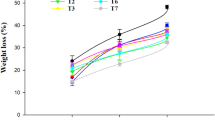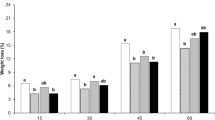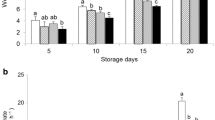Abstract
Litchi exhibits very limited postharvest life due to rapid softening and decay in spite of being a non-climacteric fruit. After the 3rd day onwards the fruit shows cracking and browning of skin. Litchi fruits after harvesting were dipped with Aloe vera and different safe products like chitosan, corn starch calcium chloride and salicylic acid. A treatment of Aloe vera 50% + Chitosan 2% was able to reduce the PLW of litchi fruits up to eighth day of storage, exhibited minimum shrinkage of the fruits, minimum change in total sugar content and titratable acidity of the fruits during 8th day of storage. Aloe vera 50% + Chitosan 1% successfully reduced the rate of increase in TSS of the fruits even up to 8th day of storage. Least change in vitamin C content during storage was observed in Aloe vera 50% + Chitosan 1% followed by Aloe vera 50% + Chitosan 2%. The same treatment reduced the incidence of fruit cracking, skin browning and decay percentage. No drastic change in organoleptic property was observed during the storage period. Hence the treatment of litchi with Aloe vera and chitosan can enhance non-refrigerated storage life of litchi up to 8 days.



Similar content being viewed by others
References
Menzel C (2001) Agriculture Reconstruction Assistance Program Williams, P. A. and Phillips, G. O. In: Phillips G, Willians PED (eds) Handbook of hydrocolloides. CRC Press, Cambridge, pp 1–19
Zhang DL, Quantick PC (1997) Effects of chitosan coating on enzymatic browning and decay during postharvest storage of litchi (Litchi chinensis Sonn.) fruit. Postharvest Biol Technol 12:195–202
Jiang Y, Duan X, Joyce D, Zhang Z, Li Z (2004) Advances in understanding of enzymatic browning of harvested litchi fruit. Food Chem 88(3):443–446. https://doi.org/10.1016/j.foodchem.2004.02.004
Siva-Kumar D, Terry LA, Korsten L (2010) An overview on litchi fruit quality and alternative postharvest treatments to replace sulfur dioxide fumigation. Food Rev Int 26:162–188
Jiang YM, Wang Y, Song L, Liu H, Lichter A, Kerdchoechuen O, Joyce DC, Shi JF (2006) Postharvest characteristics and handling of litchi fruit an overview. Aust J Exp Agric 46:1541–1556
Olivas GI, Dávila-Aviña JE, Salas-Salazar NA, Molina FJ (2008) Use of edible coatings to preserve the quality of fruits and vegetables during storage. Stewart Postharvest Rev 3:1–10
Mani A, Jain N, Singh AK, Sinha M (2017) Effects of aloevera edible coating on quality and postharvest physiology of Ber (Ziziphus mauritiana Lamk). Int J Pure Appl Bio Sci 5(6):43–53
Hussein NM, AbdAllah MMF, Abou-El-Yazied A, Ibrahim RE (2015) Sweet pepper quality maintenance: Impact of hot water and chitosan. Egypt J Hortic 42(1):471–491
Petriccione M, de Sanctis F, Pasquariello MS, Mastrobuoni F, Rega P, Scortichini M, Mencarelli F (2015) The effect of chitosan coating on the quality and nutraceutical traits of sweet cherry during postharvest life. Food Bioprocess Technol. 8:394–408
Janisiewicz WJ, Conway WS (2010) Combining biological control with physical and chemical treatments to control fruit decay after harvest”. Stewart Postharvest Rev 6(1):1–16
Raskin I (1992) Role of salicylic acid in plants. Ann Rev Plant Physiol Mol Biol 43:439–463
Hassan I, Zhang Y, Guoqiang DU, Wang G, Zhang J (2007) Effect of salicylic acid (SA) on delaying fruit senescence of Huang Kum pear. Front Agric China 1:456–459
Kumar S, Bhatnagar T (2014) Shelf life of fruits using Aloe vera based herbal coatings. Int J Agric Food Sci Technol 5(3):211–218
Ni Y, Turner D, Yates KM, Tizard I (2004) Isolation and characterization of structural components of Aloe vera L. leaf pulp. Int. Immuno. Pharmacol. 4(14):1745–55
Mani A, Prasanna VSSV, Halder S, Praveena J (2018) Efficacy of edible coatings blended with aloe vera in retaining post-harvest quality and improving storage attributes in Ber. Int J Chem Stud 6(6):1727–1733
Raychaudhuri R, Chakraborty I, Kabir J, Dhua RS (1998) Studies on the low temperature storage behaviour of pre-harvest calcium treated litchi fruits. In: Proceedings of national workshop on storage and transportation of fruits and vegetables, Kolkata, pp 20–27
Jiang Y, Li Y (2001) Effects of chitosan coating on postharvest life and quality of long a fruit. Food Chem 73:139–143
AOAC (Association of Official Analytical Chemists) (1994) Official methods of analysis, 16th edn. Virginia, USA
Baldwin EA, Burns JK, Kazokas W, Brecht JK, Hagenmaier RD, Bender RJ, Peris E (1999) Effect of two edible coatings with different permeability characteristics on mango ripening during storage. Postharvest Biol Technol 17:215–226
Hosseini MS, Zahedi SM, Abadía J, Karimi M (2018) Postharvest treatments with chitosan and putrescine to maintain quality and extend shelf-life of two banana cultivars. Food Sci Nutr 6(5):1328–1337
Thommohaway C, Kanlayanarat S, Uthairatanakij A, Jitareerat P (2007) Quality of fresh-cut guava as affected by chitosan treatment. Acta Hortic 746:449–454
Kittur FS, Saroja N, Habibunnisa-Tharanathan RN (2001) Polysaccharide- based composite coating formulations for shelf27 life extension of fresh banana and mango. Eur Food Res Technol 213:306–311
Sánchez-González L, Cháfer M, Chiralt A, González-Martínez C (2010) Physical properties of edible chitosan films containing bergamot essential oil and their inhibitory action on Penicillium italicum. Carbohydr Polym 82:277–283
Dong H, Cheng L, Tan J, Zheng K, Jiang Y (2004) Effects of chitosan coating on quality and shelf life of peeled litchi fruit. J Food Eng 64:355–358
Hong K, Xie J, Zhang L, Sun D, Gong D (2012) Effects of chitosan coating on postharvest life and quality of guava fruit during cold storage. Sci Hortic 144:172–178
Han C, Zhao Y, Leonard SW, Traber MG (2004) Edible coatings to improve storability and enhance nutritional value of fresh and frozen strawberries (Fragaria × ananassa) and raspberries. Postharvest Biol Technol 33:67–78
Son SM, Moon KD, Lee CY (2001) Inhibitory effects of various anti-browning agents on apple slices. Food Chem 73:23–30
Zhang D, Quantick PC (1997) Effects of chitosan coating on enzymatic browning and decay during postharvest storage of litchi fruit. Postharvest Biol Technol 12:195–202
Romanazzi G, Milkota-Gabler F, Smilanik JL (2005) Chitosan treatment to control postharvest gray mold of table grapes. Phytopathology 95:S90
Kumar A, Singh O, Kohli K, Dubey MC (2017) Effect of edible surface coatings on postharvest quality and shelf life of guava. Bioscan 12(2):825–832
Acknowledgements
Authors acknowledge to the Department of Post Harvest Technology, Faculty of Horticulture, BCKV, Mohanpur and Department of Plantation, Spices, Medicinal and Aromatic crops, Faculty of orticulture, BCKV, Mohanpur
Author information
Authors and Affiliations
Corresponding author
Ethics declarations
Conflict of interest
Authors declare that there is no conflict of interest to publish this manuscript.
Additional information
Publisher's Note
Springer Nature remains neutral with regard to jurisdictional claims in published maps and institutional affiliations.
Significance statement Litchi has a very low shelf life and there is a serious need for adopting a farmers’ budget -friendly shelf life extension technique. Chitosan 1% and 2% mixed with 50% Aloe vera gel was effective to retain the fruit quality, appearance and biochemical traits up to 8th day of non-refrigerated storage.
Rights and permissions
About this article
Cite this article
Mani, A., Sharangi, A.B. & Sahu, P.K. Aloe vera Based Dipping Treatments on Shelf Life and Physico-Chemical Properties of Litchi During Ambient Storage. Proc. Natl. Acad. Sci., India, Sect. B Biol. Sci. 91, 521–532 (2021). https://doi.org/10.1007/s40011-021-01248-9
Received:
Revised:
Accepted:
Published:
Issue Date:
DOI: https://doi.org/10.1007/s40011-021-01248-9




